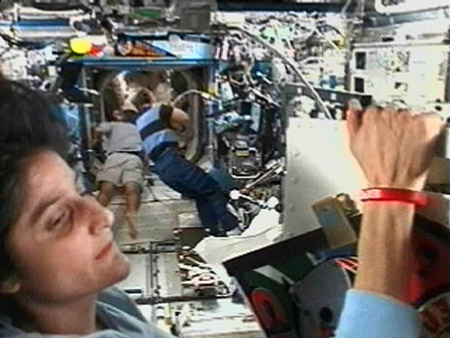US astronaut sets spaceflight record
(AP)Updated: 2007-06-17 08:59 HOUSTON - Atlantis was cleared Saturday to return to Earth this coming week after the space shuttle's heat shield was judged capable of surviving the intense heat of re-entry, and a US astronaut reached a milestone with the longest single spaceflight by any woman.
Atlantis is set to land at Cape Canaveral, Fla., on Thursday, although NASA officials were still deciding whether to keep the shuttle at the international space station for an extra day because of a failure of computers that control the station's orientation and oxygen production.
"That's great news," Atlantis commander Rick Sturckow said of the landing plan.
The shuttle's 11-day space station construction mission had already been extended to 13 days so a thermal-protection blanket could be fixed during an unscheduled spacewalk. NASA has been particularly sensitive about the space shuttles' heat shields since the Columbia accident killed seven astronauts in 2003.
Also Saturday, US astronaut Sunita "Suni" Williams set a record for the longest single spaceflight by any woman. Williams, who has lived at the space station since December, surpassed the record of 188 days set by astronaut Shannon Lucid at the Mir space station in 1996.
"It's just that I'm in the right place at the right time," Williams, 41, said when Mission Control in Houston congratulated her on the record. "Even when the station has little problems, it's just a beautiful, wonderful place to live."
Those "little problems" had been considerable in recent days with the computer system failure on the Russian side of the station. Russian cosmonauts Fyodor Yurchikhin and Oleg Kotov got four of six processors on two computers working again on Friday, and on Saturday they got the remaining two on line.
Engineers in Moscow and Houston had not yet conclusively determined what caused the failure, although the leading theory was changes to the electrical system from the space station's growth.
The cosmonauts started turning on systems -- such as an oxygen machine, a water processor and a carbon dioxide remover -- that had been turned off while the computers were down. On Sunday, they planned to test the station's orientation system, which will be the final benchmark for deciding whether the computers work properly and whether the shuttle needs to stay an extra day.
"The bottom line is it appears that the command and control type computers are functioning just fine," said Mike Suffredini, NASA's space station program manager.
In preparation for Tuesday's scheduled undocking of the shuttle, astronauts and cosmonauts spent Saturday moving supplies and trash between the shuttle and station after several days of grueling work.
Friday's tasks had included spacewalks to repair the torn thermal blanket on Atlantis and to retract a 115-foot solar energy wing that will be moved to a different location on the space station.
Williams' former crew mate at the space station, astronaut Michael Lopez-Alegria, holds the US record for longest continuous stay in space with 215 days. The longest stay in space was 437 days by Russian Valeri Polyakov.
In February, Williams set another record for the most time spent spacewalking by a woman, kicking off a year of achievements by women in space.
In October, US astronaut Peggy Whitson will become the first woman to command the space station. Later that month, Air Force Col. Pam Melroy will become only the second woman to command a space shuttle mission; Eileen Collins was the first, in 1999.
If Whitson and Melroy's time at the space station overlap, it could be the first time there are two female commanders in space at the same time. "The first time we have two female commanders in orbit -- that will be neat," Whitson said.
Almost three decades after the first women joined the astronaut corps in 1978, only 17 of the 94 current active astronauts are women.
Lucid says part of the problem may be the pipeline that delivers pilots to the astronaut corps -- the US military. Women didn't start entering the military service academies until the late 1970s.
"I think it's really great that all of this happening, but obviously, you wonder, why did it take so many years?" asked Lucid, who is in astronaut office management. "At some point, you would like the field to be such that it doesn't make any difference whether you're male or female."
On the ground, Mission Control had its first female flight director in 1985. All three space station flight directors working the current Atlantis mission, and the lead shuttle flight director, are women. Women make up about a third of NASA's 33 flight directors, who are responsible for running the spaceflight missions.
"So many times, the room is filled with female flight controllers," Lucid said. "I just think it's just a wonderful thing that people are getting the chance to do what they're capable of doing."
|
||
|
||
|
|

